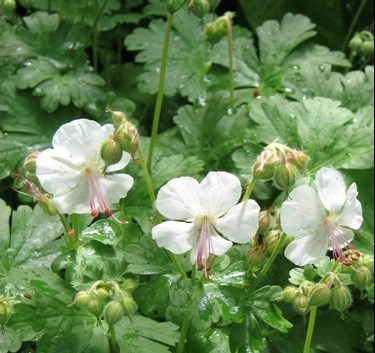The Perennial Plant Association is a trade association composed of retailers, landscapers, educators and other professionals interested in the growing, selling and promotion of herbaceous perennials. One of their programs is the Perennial Plant of the Year where they select an outstanding, proven performer to promote across North America. This year, they have chosen Biokovo perennial cranesbill geranium (Geraniumx cantabrigienseBiokovo) as their star.
Biokovo geranium is a naturally occurring hybrid found in the Biokovo Mountains of Croatia. It’s a real attention getter, sporting white blooms with bright pink stamens that lend the flowers an overall pink blush. Not only do the masses of flowers attract attention, it keeps blooming for four weeks or more in early to mid-summer (and on occasion, re-blooms in the fall). Bees, butterflies and other pollinators can’t get enough of the blooms. And the show doesn’t stop there: the leaves offer up shades of scarlet, orange and bronze in the fall.
The plant is compact, low to the ground (15 – 20 centimetres tall), forming a moderately fast growing groundcover, up to one metre in diameter. It spreads by shallow, somewhat fleshy rhizomes (underground stems) that are easy to pull out of the ground to control its spread. The leaves are medium green, slightly glossy, lobed and fragrant. They are also semi-evergreen, adding some early colour to the garden.
Equally at home in full sun or part shade, it is a very adaptable, long-lived perennial that can be grown in borders (at the front), rock gardens or containers. Make sure it is growing in well-drained soil for best results. It is not tolerant of overly wet environments and, in fact, is tolerant of dry shade (once established) making it a perfect plant for under trees, eaves and other difficult, dry areas in the garden. But do give it water on occasion during prolonged dry periods.
When planting, make sure the crown is just at or above the soil surface after watering in. Division in spring or fall is easy: dig up pieces from the edge of the mound, keeping as much soil with the roots/rhizomes as possible, and replant as above – no need to dig deep as the root zone is only about 10 centimetres deep. It’s low maintenance as well: remove dead or ragged leaves in spring before growth begins and give it a hard trim right after flowering to trigger a flush of new growth to renew its appearance. In addition, it has good disease resistance and reportedly tolerant of deer and rabbits. Note for rural folks: in my experience, this latter point can either mean deer and rabbits avoid it or plants tolerate and recover quickly after browsing.
Now, before I’m accused of being a climate zone denier again, Biokovo survived several years in my old garden (it may still be there, but I haven’t been to visit since moving away), despite the fact that most sources rate it only for USDA zone 4 or 5 and warmer (Saskatoon is USDA zone 3b).
— This column is provided courtesy of the Saskatchewan Perennial Society (www.saskperennial.ca; hortscene@yahoo.com). Check out our Bulletin Board or Calendar for upcoming garden information sessions: January 28-Developing the Gardens at Tierra del Sol.



